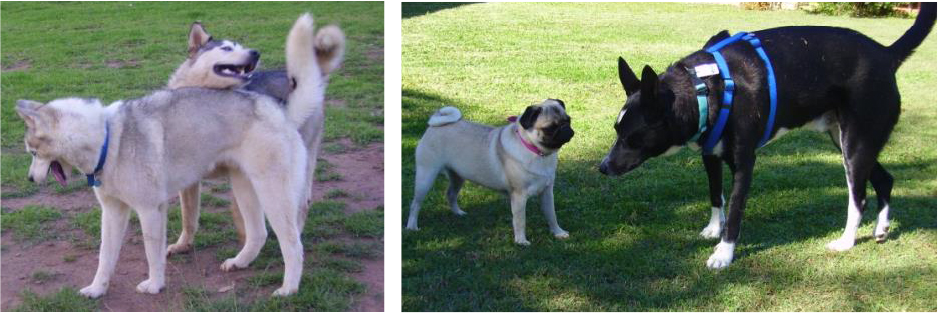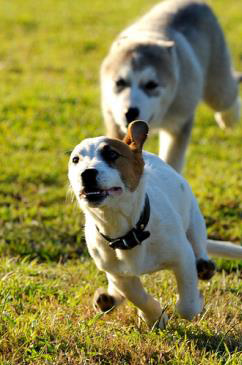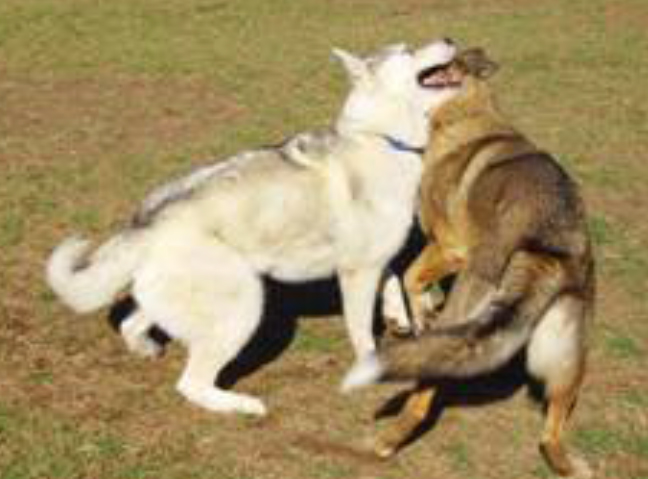Read The Art of Introducing Dogs Online
Authors: Louise Ginman
The Art of Introducing Dogs (3 page)
Male to female
This is generally the best way to introduce and house dogs. Whether desexed or not, this combination nearly always works. Notice I said ‘nearly’ because again, some factors like previous socialisation history can affect one or both dogs.
Female to female
(Warning - two females of 5-6 years can be difficult)
There is a reason they are called ‘bitches’. All jokes aside, this can be a difficult combination and is made worse if the females are not desexed and are very close in age and size. Dog trainers have found that the worst fighting cases they are called to ‘fix’ is between two females who are now both 5–6 years of age. Often, one of those females needs rehoming as the fighting is so severe and persistent that the quality of life for one or both is drastically affected. If the ages of the females are staggered i.e. introduce a female pup to female who is 3 years or older, then it can work well for the life of the dogs.
Multiple dogs to a newcomer
If you already have multiple dogs, chances are you also have a mixed sex group. You need to ask yourself whether your current pack really needs a newcomer as there are quite a few personalities to consider. The new dog could feel outnumbered, feel threatened - depending on how much previous contact they have had with other dogs - or totally change the dynamic of the home. Some people introduce newcomers successfully and with ease while others struggle. Generally speaking, the more dynamic your mini pack has been over the years, the easier it will be to introduce a new dog — in other words, if you have always had a constant stream of dogs coming and going, you will integrate a new dog fairly easily but if your pack has been extremely stable with no newcomers for a long time, then the introduction of a new dog could be much harder.

(Left photo) These two desexed males are of similar size, age and breeds. When first introduced they regularly fought. It took 3 months of introductions 3 times per week at the local dog park for these dogs to feel comfortable with each other and play. (Right photo) The large 5 year old male is being introduced to a 1 year old female Pug. This male does not accept new dogs easily. He has a tense posture with closed mouth and a still erect tail whilst also making direct eye contact.

Look at the body language of the dogs in these photos. On the left is the large male who feels tense around the Pug. The male lunged forward at the female Pug causing her to retreat. A successful introduction between these two dogs would be a long slow process. On the right, the same female Pug was introduced to a 6 year old male Siberian Husky. This photo was taken on day three. The dogs have relaxed bodies, tails and open mouths. This introduction was successful with only three meetings.
There are no hard and fast rules about what will work best in your home. Even within breeds, each dog is an individual that has had a unique set of experiences. Therefore, when looking at what works best, you need to focus on the individuals involved.
In general, the most compatible dogs will be ones who have similar play styles, are opposite sexes or, if same sex, are desexed and separated in age by more than 2–3 years and will be of similar adult sizes e.g. a Chihuahua with a Siberian Husky is probably not going to be a good mix because the size difference is too great and play could turn into predatory behaviour or simply become too rough and dangerous for the small dog.
Matching play styles mean less stress to the dogs. Think of it this way - we look for people with similar qualities to us either for friends or partners. If we like our personal space, then we generally won’t pick a ‘close talker’ to be our mate because it infringes on our space, making us uncomfortable. Likewise, your dog has set qualities that if matched correctly, will lead to a more contented life with less frustrations and tension.
Four common play styles are
1
- Chasing,
- Neck biting,
- Cat-like play and
- Body slamming.


These dogs are wrestling and neck biting. The dogs are a similar size. Provided both dogs take it in turns to be the dog ‘on top,’ this type of play is acceptable.
Chasing
works best when one dog likes to be chased and the other likes to chase. When this works well, both dogs should be relaxed, have a more loping or free moving run, have open relaxed mouths and tails flowing. Chasing can turn predatory so watch for tension in the body, tucked tail in the dog being chased, closed mouths and increased fixation/intensity in the chaser. Interrupt this type of chasing immediately and redirect the dogs to a calmer activity.
Neck biting
is a type of wrestling behaviour where the dogs grab and mouth each other’s’ neck, face or ear area. They often tire and flop onto the ground to continue wrestling on their sides. Their bodies are loose and relaxed and play is balanced and reciproca, which means each dog takes turns to be the dog on top or the dog to mouth the other.
Cat-like play
occurs when dogs bat each other with their paws and spin around or make exaggerated movements often without even touching each other. This play style is usually seen in small or toy breeds.
Body slamming
is commonly seen in the large breeds. It involves dogs shoulder slamming or body slamming each other with or without floor wrestling. This type of play looks and can be quite rough. Large dogs should be monitored around smaller breeds as body slamming may make smaller dogs feel uncomfortable because of its rough and tumble nature, or may cause them injury.

Body slamming is a common play style for Siberian Huskies These dogs have loose relaxed bodies and Mouths. They are equally matched in size and play styles
.
Different breeds also have different play styles so before deciding on a breed (or mixed breed), watch a whole variety of dog breeds playing at the park or visit breeders and watch the play styles of that breed to best match the new dog with your current one/s. Thoroughly research the different breeds. Find out what they were bred to do, how much exercise they need, how they play and what behaviours you can expect from the breed. You will then be in a better position to consider whether a dog of this breed will be compatible with your current dog/s. If you are looking at getting a mixed breed dog, then you need to try to identify at minimum, the two primary breeds that the dog is a mix of and research both those breeds. Your mixed breed dog will show a combination of traits from each of the breeds that it has in its genetic makeup.
What is a ‘socialisation history’ and why is it important? Socialisation is the process of accustoming and exposing your dog to a variety of stimuli in the environment so that your dog is familiar and accepting of those stimuli as an adult. Stimuli includes everything from animate (living and non-living things) and inanimate objects as well as sounds, smells and sights. When talking about introductions to other dogs, I refer to socialisation of your dog/s to other dogs of all sizes, ages, colours (coat and eye), hair types and breeds. Socialisation history is an inventory of all the experiences your puppy/dog has had from birth till right now with other dogs. Depending on how positive or negative the experiences were, they will influence your dogs’ reaction to future experiences.
One important thing to realise about socialisation is that the process needed to primarily occur while your dog was a puppy. Once a pup becomes an adult, the window of opportunity has pretty much closed. If you have a puppy, the following information is current and vital for you now. If you have a juvenile or adult dog, take note for the future if you missed the window of opportunity. Alternatively, congratulate yourself on a job well done if you ensured your dog was well socialised from puppy hood until now.
From 3–12 weeks of age is a major sensitive period where it is vital to socialise your pup to all the stimuli that will be present in your dog’s adult life. That’s a pretty big list to cross off, with very few weeks to do it. Puppy classes should be high on your list to kick start the process. Every pup you raise needs to go to puppy classes while under 12-16 weeks of age to gain exposure to other breeds in a safe environment. Just because you have put one pup through puppy preschool does not mean you now know it all and don’t need to take subsequent pups. Each pup (remember this is not about you, it’s about your pup) needs to go to puppy class. Read Dr Ian Dunbar’s books listed in the resources section for more information on the importance of socialisation and the short window of opportunity you have to do it. Dunbar recommends that by 12 weeks of age, your pup should have met 100 people (from babies upwards), been exposed to numerous (vaccinated and well socialised) dogs and environmental stimuli.
By 16 weeks of age, most puppies will have finished their course of vaccinations and will be well on their way to adolescence. At 16 weeks, you have very little time left to get your dog well socialised with other dogs, as in another 8 weeks, it will be too late for the majority of dogs. So if you haven’t done so already, 16 weeks is the time to get out and about — go for daily walks, go to dog parks, beaches, obedience or pet dog training classes. See and meet as many friendly, well socialised dogs as possible. Notice the use of ‘friendly, well socialised dogs’. The best way for your pup to become reactive, defensive or aggressive to other dogs now or in the future, is to have a ‘socialisation accident’ where your puppy is traumatised via bullying, harassment or an outright attack with or without injuries. One traumatic event can trigger long term or permanent dog-dog issues or it could occur due to a series of less serious events. The better your dog is socialised — i.e. the more positive encounters they have, the more forgiving they are when those socialisation accidents occur.
